Genre: Compilation Developer: Sonic Team Publisher: Sega of America Players: 1-2 Released: 1997
Oh, how the mighty fall.
In just a scant few years, SEGA, who by 1997 was finally committed to the Saturn (with the exception of a few Genesis stragglers that allowed the 16-bit era to register a faint pulse), had gone from the little-known underdog struggling to make a name for itself in the Nintendo-dominated market to the Big N’s equal. However, just as SEGA entertained the idea of becoming the top dog, it found itself slipping. Sadly, in quicker fashion than the company’s seemingly overnight rise to the top, SEGA increasingly became a video game afterthought.
The impetus for SEGA’s downfall is well documented: the company’s decision to flood the market with new hardware, the sporadic commitment to these systems, and a severed sense of communication between corporate SEGA and the developers and consumers. These were all mitigating factors, yet maybe more so than any other problem, one dynamic can be attributed to the fall from grace. I’ll give you a hint; this was also the factor that catapulted SEGA to the top: Sonic The Hedgehog.
The original Sonic The Hedgheog landed a surprise uppercut on Nintendo. Sonic 2 put the hedgehog’s rival into the corner. By 1994, SEGA had Nintendo down for the count, what with the release of two full-fledged Sonic games (or one massive romp, if you remember it in the way I choose to). It seemed the company could do no wrong, yet just two and a half years later, SEGA was gasping for air. The market was ready for the dawn of the 3D age. SEGA finally moved to a new flagship system in the Saturn, but evidently Sonic did not want to make the trek with them.
What with Sonic Team taking a hiatus from the series and the cancellation of Sonic X-Treme, Sonic was notably missing in action at a time when his company needed him the most. With Super Mario 64 providing the blueprint for success in developing a 3D platformer and Sony reaping enormous benefits from a slew of Sonic knockoffs, it became clear that the public clamored for more from their favorite blue hedgehog.
What consumers actually received from SEGA probably was not what they had in mind. Indicative, of the company’s mind set at this stage of the game (pardon the pun), SEGA tried quick fixes for an ailment that required a more concrete solution. I can only imagine what a decent full-on Sonic game would have done to jump-start the slumping Saturn. Alas, the key word there is imagine, because rather than listening to the concerns of its fan base, SEGA released Sonic games on its terms: Sonic 3D Blast (a souped-up version of a poorly received, yet underrated, Genesis game), Sonic R (a solid racing game that was just good enough to make the yearning for a new Sonic platformer even stronger), and Sonic Jam. Not a terrible line up, but not exactly murderer’s row. While each game has its own merits, Sonic Jam is without a doubt the cream of this particular crop. Its combination of old and new features will all be looked at individually, starting with the original series and concluding with game’s bonus features.
What makes Sonic Jam so unique, when compared to other Sonic compilations, is that each series entry has been tweaked in some way. Rather than just port the Genesis games as-is, SEGA actually (gasp!) showed some creativity. These changes do not alter the way the games play drastically, but in many cases, they mark some vast improvements.
For example, in the first Sonic, the most obvious Jam difference is the inclusion of the spin dash. Introduced in Sonic 2, this compilation allows players to go back and give the move a go in the original game. While this does not make the game leaps and bounds easier, it comes in handy in the rare instances of gameplay hold-up. Who needs to backtrack and get a running start to roll up a hill when you can simply spin dash your way to the top? This move adds to the formula of “speed, speed, and more speed” without trimming any of the game’s difficulty.
While many other gameplay changes occur in all four games (mostly in the sound department, but it should be noted that Sonic now features a trail of dust whenever he screeches to a halt, a la Sonic 2), Sonic Jam features other oddities. For the first time, you can play the Genesis games with alternate levels of difficulty. Now, you could play a quick run-through on “easy” omitting badniks, bosses, and even some acts. Or, you could try “normal” mode, which does not feature as many omissions, but injects a lot more rings into each level. Finally, you could simply decide to play the games in their original form (with the option of turning the spin dash on or off in Sonic 1).
As a bonus, not only does Sonic Jam provide convenient access to the original Sonic games, but it also eliminates the hassle of switching cartridges in and out. Now, Blue Spheres, Knuckles in Sonic The Hedgehog 2, and Sonic The Hedgehog 3, and Sonic & Knuckles populate the same disc. This may seem like old hat now, but it should not be discounted that this was the first compilation to feature all of these games in one package.
Perhaps more than the Genesis compilation, the fully 3D Sonic World proved to be the greatest reason to purchase Sonic Jam. If it’s possible to transport yourself back to the summer of 1997, when you are first operating Sonic in a 3D environment, I think it’s safe to assume that there was one question on your mind: “Why does SEGA hate me?” for Sonic World provides a tantalizing glimpse at what could have been.
To torture players even more, Sonic World features tiny missions, as if this were the demo of a game that was never meant to be (although it’s been confirmed that this was an early test for Sonic Adventure, but you get my drift). These missions ranged from collecting a certain amount of rings to finding a missing Tails. Not exactly complex, but it is the only taste of 3D platforming you will get from Sonic on the Saturn. To top it all off, it features background music that I promise will stick in your head for quite some time. It is probably the most dated aspect of the game (if you buy into my belief that 16-bit games have aged better than the 32-Bit 3D offerings), but it will easily siphon time out of your day and have you coming back for more.
The final feature in Sonic Jam should not have its importance brushed aside. Within the Sonic World are various museums. In the museums you will find a veritable gold mine of all things Sonic The Hedgehog. Among the extra features within the museums, players will discover documented history, samples of art, the uncut Sonic CD animation sequence, audio clips, and, my favorite, commercials and advertisements. If you are looking to take a trip down memory lane and overcome yourself with a sense of nostalgia, the museums must be looked at. Given the fact that emulation and later compilations have made the Genesis games so accessible and that Sonic World might seem like a primitive eyesore to some, it is debatable that the museums are the best part of Sonic Jam.
While it seems possible to spend all day arguing the merits of each of the game’s features, one thing is clear: there is more to Sonic Jam than meets the eye. With the inclusion of Sonic World and the museums, the game continues to be the gold standard by which all compilations are measured, even topping later Sonic collections. In addition, by offering plenty of old-school fare in conjunction with tantalizing sneak-peeks as to what the future held for the blue hedgehog, Jam distances itself from its Saturn hedgehog brethren. And while it was unable to save SEGA from its ultimate fate, the game still constitutes “must-own” status and has become one of the Saturn’s true diamonds in the rough.
SCORE: 10 out of 10
Sonic World screens property of the Green Hill Zone.

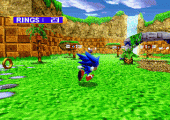
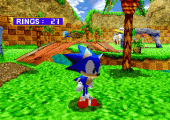
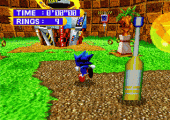
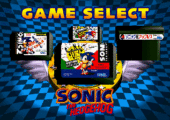
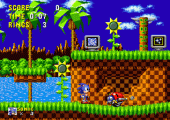
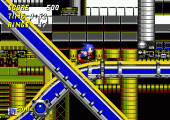
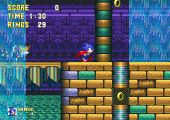
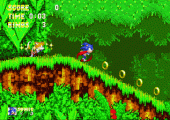
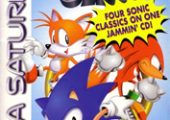
Recent Comments